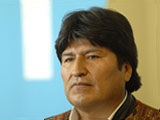Behind the Morales Assassination Plot
By Samuel Logan for ISN
Hours before dawn on 16 April, members of an elite Bolivian police squad cut the phone lines of Las Americas Hotel in Santa Cruz, Bolivia before they entered three rooms on the fourth floor. There were reports of at least 15 minutes of gunfire before the bodies of three men were removed. Two others were arrested.
The Bolivian government quickly announced that it had broken up a terrorist cell that had planned to assassinate the president.
Now, over a month later, doubt clouds the investigation of a group of foreign nationals allegedly hired by Bolivian opposition leaders to kill President Evo Morales.
Many analysts agree that the Bolivian government, at the very least, has used the incident to discredit the Santa Cruz-based opposition ahead of December presidential elections.
Since Morales’ first election, he has worked hard to increase the power and legal rights of Bolivia’s lower classes.
Whether or not Morales bent the law to change Bolivia’s constitution, the results are the same. He has increased the power and wealth of his constituency, remains a popular leader, and is likely to be reelected in December.
Bolivia’s opposition has been constantly hemmed in. Nearly every effort to go against the government has been met with stiff resistance. Their position has been violent at times, and has appeared desperate at others.
In September 2008, political violence in Santa Cruz and other the cities of Bolivia’s eastern lowlands regions killed some and injured many. At the center of the more violent pockets of activity were groups of youth unions.
Connections to leaders in Santa Cruz were quickly discovered when investigators revealed that one of the men arrested on 16 April, Juan Carlos Gueder, was a security advisor for the Santa Cruz Youth Union. Branco Marikovic, a former leader of the Santa Cruz Civic Committee, and Ruben Costas, the governor of Santa Cruz department, were also linked to the plot to kill Morales.
The government’s evidence, however, remains problematic. One three-minute video that links the deceased “terrorists” to a plot to kill Morales was apparently made with a cell phone and is of very poor quality.
The Irish Times has reported extensively on the death of Michael Dwyer, an Irish man who died in the hotel on 16 April. He was killed by one shot in the chest and died in his underwear, suggesting that he – and the others - might have been killed in their sleep.
Before Dwyer’s body was repatriated, Bolivian investigators likely made no attempt to test for gunpowder resin on his hands, according to the external pageIrish Timescall_made.
Dwyer apparently worked as a bodyguard for one of the other “terrorists” and alleged cell leader, Bolivian-Hungarian, Eduardo Rosza Flores. Yet Rosza reported to a Hungarian, Tibor Revesz, who allegedly had ties to the CIA, a Bolivian politician external pagetoldcall_made local media.
Morales, however, has remained relatively quiet about any plot to kill him since he removed the US ambassador to Bolivia, the Drug Enforcement Administration and USAID in September 2008.
If any result has come of this whole terrorist cell fiasco, it has been to place Bolivia’s opposition on unsure footing, ensuring Morales’ administration of a weapon to keep its detractors on the defense through the upcoming elections. Never mind an assassination attempt could happen again.

